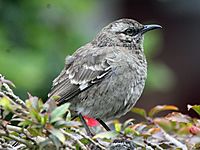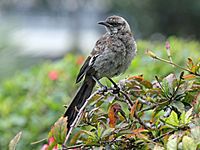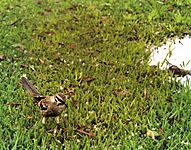Long-tailed mockingbird facts for kids
Quick facts for kids Long-tailed mockingbird |
|
|---|---|
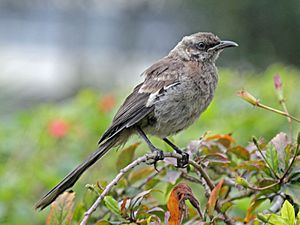 |
|
| Conservation status | |
| Scientific classification | |
| Genus: |
Mimus
|
| Species: |
longicaudatus
|
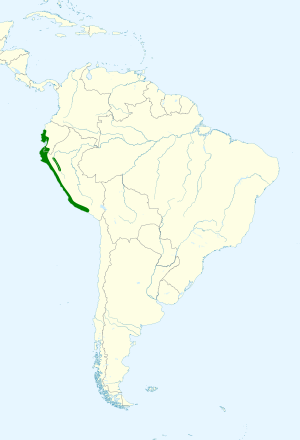 |
|
The long-tailed mockingbird (Mimus longicaudatus) is a type of bird that belongs to the Mimidae family. This bird is known for its long tail! You can find it living in Ecuador and Peru.
Contents
About This Bird's Family
Birds are often grouped into different types, like a big family tree! The long-tailed mockingbird has four main groups, called subspecies. Think of them as slightly different versions of the same bird. These are Mimus longicaudatus longicaudatus, M. l. platensis, M. l. albogriseus, and M. l. maranonicus.
What Does It Look Like?
The long-tailed mockingbird is about 27 to 29.5 centimeters (around 11 inches) long. It weighs between 54 and 79 grams (about 2 to 3 ounces). Male birds are usually a little bigger than females.
Adult birds have a wide white stripe above their eyes, like an eyebrow. They also have a black stripe going through their eye. Their head and back are brownish-gray with darker streaks. Their wings and long tail are mostly dusky brown. You can see white patches on their wings and tail when they fly. Their throat and belly are white, and their chest is a dull brown color. Young birds look similar but have streaks on their chest.
The different subspecies have small differences. For example, M. l. albogriseus is smaller and grayer. M. l. platensis is similar but has a longer beak.
Where Does It Live?
The long-tailed mockingbird mostly lives along the Pacific coasts of Ecuador and Peru.
Specific Locations
- The main group, M. l. longicaudatus, lives along most of western Peru.
- M. l. albogriseus is found in southwestern Ecuador, reaching into Peru.
- M. l. platensis lives only on Isla de la Plata, an island about 30 kilometers (19 miles) off Ecuador's coast.
- M. l. maranonicus is different because it lives inland along the upper Río Marañón in northwestern Peru.
Bird Habitats
These birds like to live in coastal desert areas with scrub bushes and dry woodlands. They also live in hedgerows and tree groves on farms. You might even spot them in gardens and parks! The birds near the coast live from sea level up to about 1,900 meters (6,200 feet) high. The M. l. maranonicus subspecies, which lives inland, can be found as high as 2,450 meters (8,000 feet).
Behavior
What Do They Eat?
Long-tailed mockingbirds usually look for food on the ground. They hop and glide between places where they find food. They eat many different things, including insects and other small creatures. They also enjoy fruits and berries. When it's not breeding season, they often hang out in loose groups.
Reproduction and Nests
Long-tailed mockingbirds build their nests from late December to July in southwestern Ecuador. They are territorial, meaning they protect their nesting area. Their nest is a rough cup made of thorny twigs. It's lined with softer plant material and hair. They usually place their nests in a spiny bush or cactus, often up to 5 meters (16 feet) above the ground.
A female bird usually lays three or four eggs. The eggs are greenish with reddish-brown spots. Sometimes, other birds, like shiny cowbirds, lay their eggs in the mockingbird's nest.
What Do They Sound Like?
The long-tailed mockingbird's song is a fairly slow mix of rich whistles, churrs, rattles, and other noises. They often repeat parts of their song. Their calls sound like a throaty "garr!" or a raspy "gaawrr". Unlike some other mockingbirds, this species is not known to copy the songs of other birds.
Status and Conservation
The IUCN (International Union for Conservation of Nature) has looked at the long-tailed mockingbird. They have decided it is a species of "Least Concern." This means that it is not currently in danger of disappearing.
The two groups of birds living on the mainland coast are common. However, their homes are sometimes spread out because their habitat isn't continuous. The island home of M. l. platensis is small, but part of it is protected by a national park. The M. l. maranonicus subspecies also has a small living area.
Gallery
See also
 In Spanish: Sinsonte colilargo para niños
In Spanish: Sinsonte colilargo para niños



